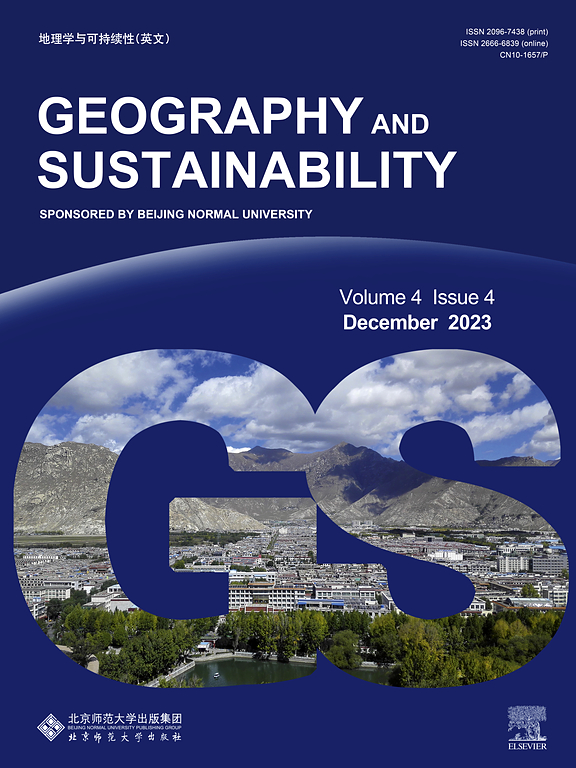Global sustainable agriculture and land management systems
IF 8
1区 环境科学与生态学
Q1 GEOGRAPHY, PHYSICAL
引用次数: 0
Abstract
The paper introduces a Special Issue based on presentations to the Agricultural Geography and Land Engineering (AGLE) Commission sessions of the International Geographical Union (IGU) at the IGU’s Congress in Paris in 2022. The sessions contrasted different approaches towards attaining greater sustainability in agricultural production to satisfy the need to feed the ever-increasing human population, currently expected to reach close to ten billion by 2050. After considering the multi-faceted problem of defining sustainable agriculture, this introduction systematically outlines broad strategies to attain the varied outcomes desired by agricultural systems. Presenting a contrast between ecocentric and technocentric approaches provides opportunities to synthesize recent literature addressing the pros and cons of these two broad alternatives. Recognition of the ecological and socio-cultural benefits accruing from the ecocentric has long been championed by proponents of a wide range of environmentally friendly farming systems, including organic farming, climate-smart agriculture, agroforestry, and permaculture. The technocentric lies at the heart of so-called Agriculture 4.0, in which innovations such as precision farming, digital technology, and genetic modification are applied to increase production per unit area. The potential for technology to ‘solve’ the world’s food crisis is supported by those who argue that ecocentric approaches alone cannot meet the rising demand for food. Yet, questions remain about the sustainability of new technology-based methods, so a strong and ongoing debate continues regarding how to attain greater sustainability alongside increasing agricultural output. This debate is exemplified in the contributions to the Special Issue outlined herewith.
全球可持续农业和土地管理系统
本文介绍了在 2022 年巴黎国际地理学联合会(IGU)大会上,根据国际地理学联合会(IGU)农业地理与土地工程(AGLE)委员会会议上的发言编写的特刊。会议对比了实现农业生产更大程度可持续性的不同方法,以满足养活不断增长的人类人口的需要,目前预计到 2050 年,人类人口将接近 100 亿。在考虑了界定可持续农业的多方面问题之后,本导言系统地概述了实现农业系统所期望的各种成果的广泛战略。通过对比生态中心方法和技术中心方法,我们有机会综合近期的文献,探讨这两种方法的利弊。长期以来,包括有机耕作、气候智能农业、农林业和生态农业在内的各种环境友好型农业系统的支持者一直在倡导生态中心所带来的生态和社会文化惠益。技术中心主义是所谓的农业 4.0 的核心,在农业 4.0 中,精准农业、数字技术和转基因等创新技术被用于提高单位面积的产量。有观点认为,仅靠以生态为中心的方法无法满足日益增长的粮食需求,因此,技术 "解决 "世界粮食危机的潜力得到了支持。然而,以新技术为基础的方法的可持续性问题依然存在,因此,关于如何在提高农业产量的同时实现更大的可持续性的激烈辩论仍在继续。本特刊所收录的论文就是这场辩论的例证。
本文章由计算机程序翻译,如有差异,请以英文原文为准。
求助全文
约1分钟内获得全文
求助全文
来源期刊

Geography and Sustainability
Social Sciences-Geography, Planning and Development
CiteScore
16.70
自引率
3.10%
发文量
32
审稿时长
41 days
期刊介绍:
Geography and Sustainability serves as a central hub for interdisciplinary research and education aimed at promoting sustainable development from an integrated geography perspective. By bridging natural and human sciences, the journal fosters broader analysis and innovative thinking on global and regional sustainability issues.
Geography and Sustainability welcomes original, high-quality research articles, review articles, short communications, technical comments, perspective articles and editorials on the following themes:
Geographical Processes: Interactions with and between water, soil, atmosphere and the biosphere and their spatio-temporal variations;
Human-Environmental Systems: Interactions between humans and the environment, resilience of socio-ecological systems and vulnerability;
Ecosystem Services and Human Wellbeing: Ecosystem structure, processes, services and their linkages with human wellbeing;
Sustainable Development: Theory, practice and critical challenges in sustainable development.
 求助内容:
求助内容: 应助结果提醒方式:
应助结果提醒方式:


